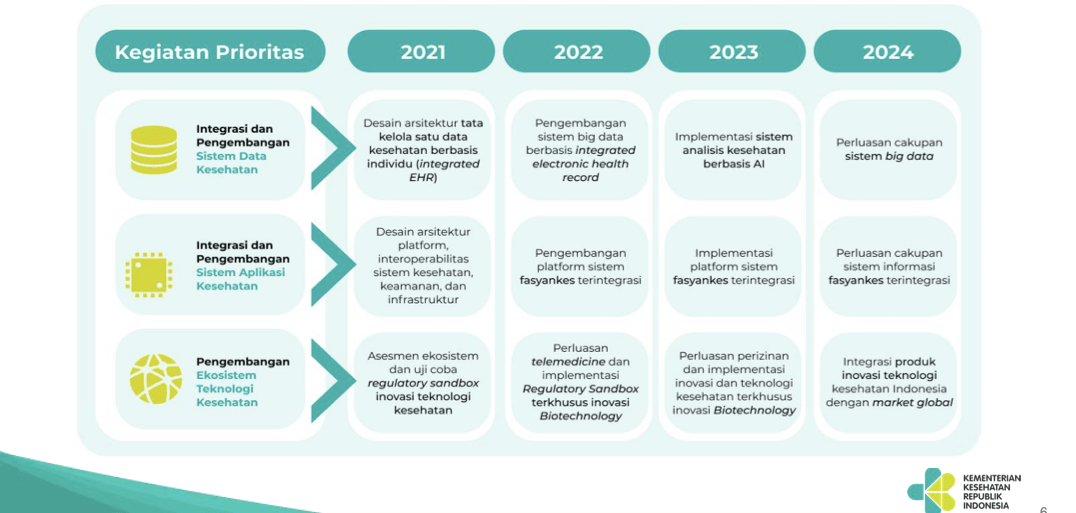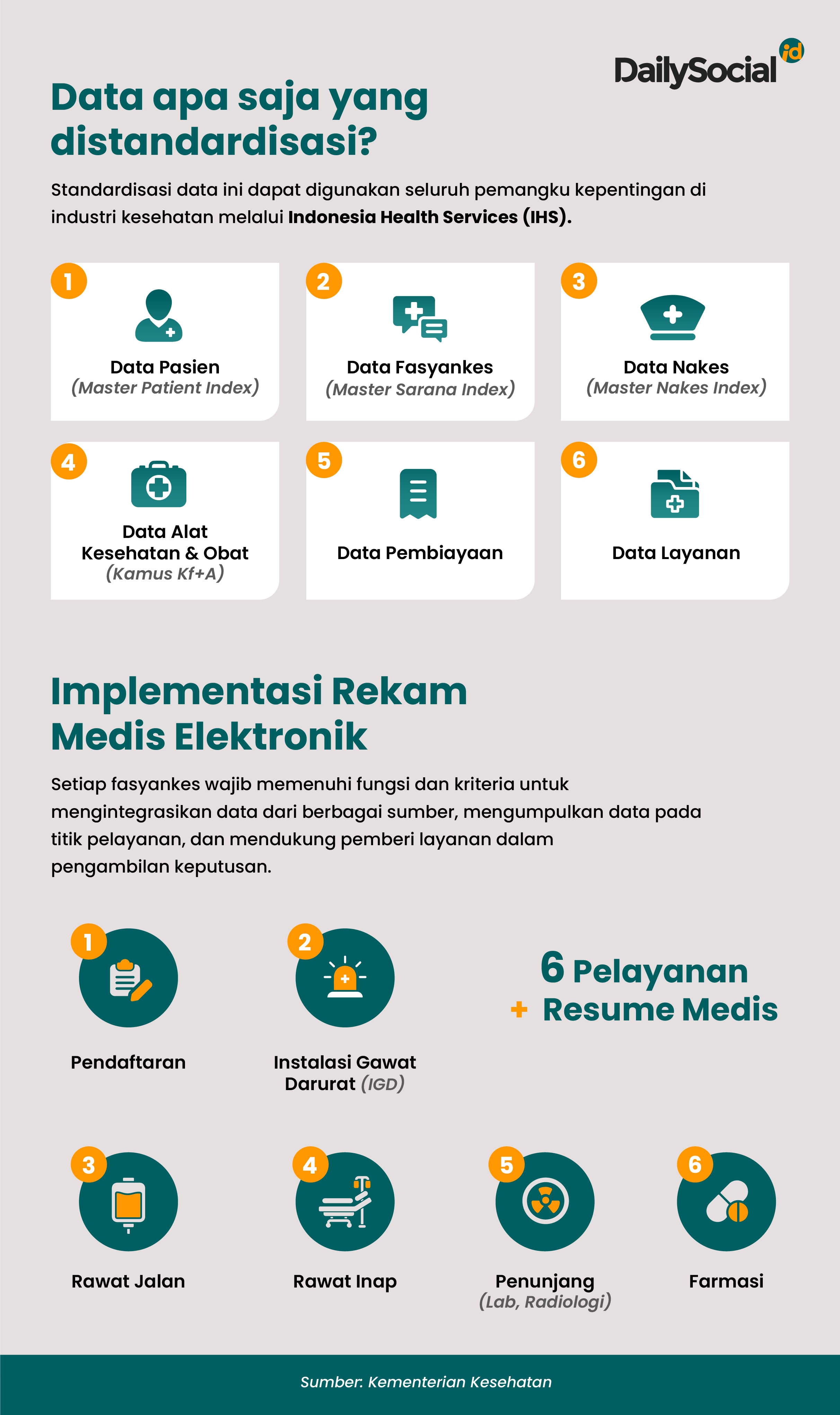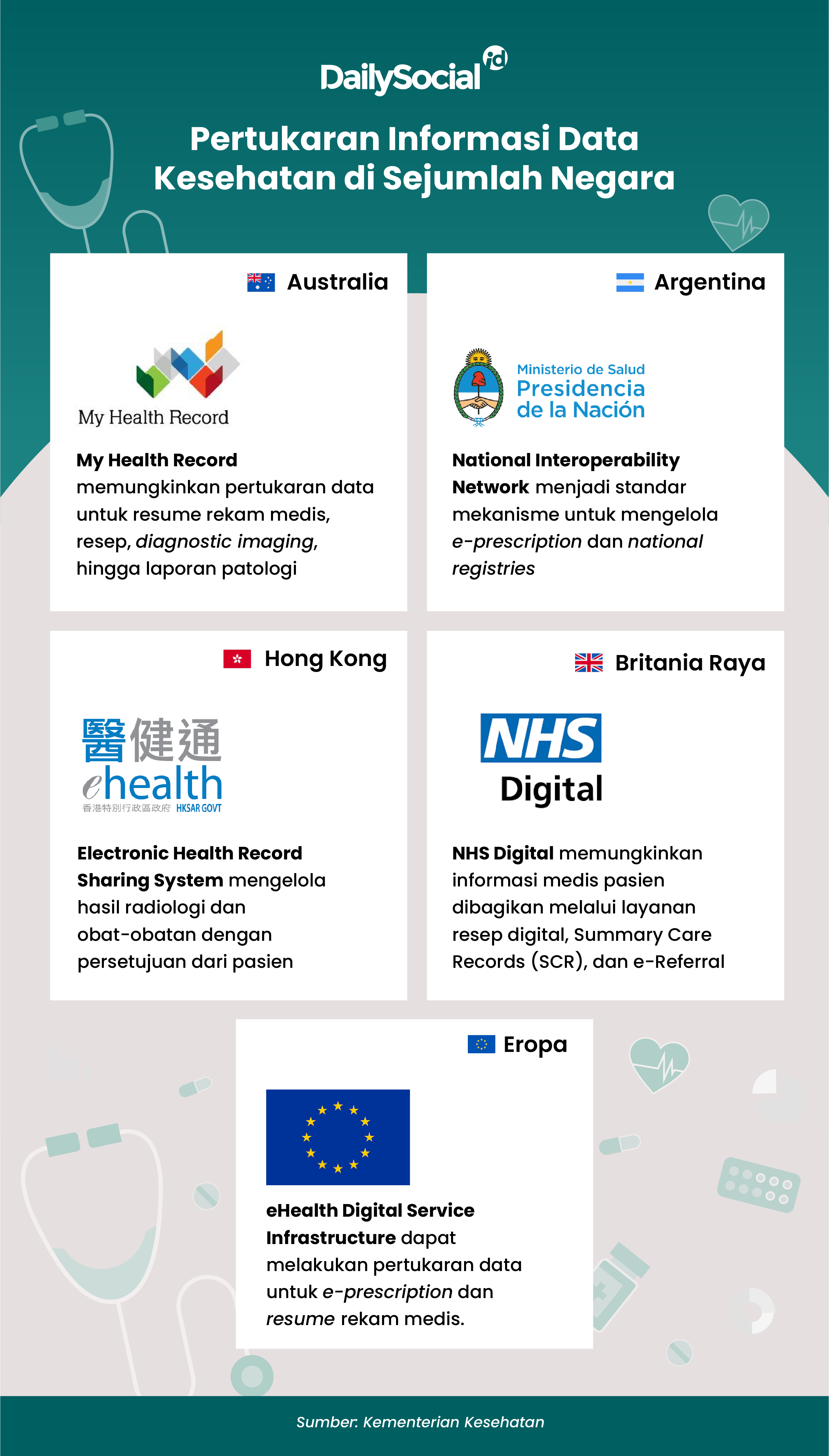Progressive Steps Towards Connected Health Data Information
Within one year, the Ministry of Health has launched a transformation roadmap, the "One Healthy" platform, and regulations for implementing Electronic Medical Records
The Covid-19 pandemic has become an important catalyst for the Ministry of Health (Kemenkes) to transform the Indonesian health industry. Like a super-fast train, the Ministry of Health has implemented a number of very progressive steps over the past year to initiate its transformation.
Since the end of 2021 until now, the big agenda of the Ministry of Health is reflected in the realization of the launch (1) digital transformation roadmap(2) regulatory sandbox, (3) the Indonesia Healthcare System platform named "Satu Sehat", and—one of the most significant—(4) new regulations regarding the implementation of Electronic Medical Records (RME).
Point number four is a crucial element in smoothing the health industry transformation agenda. However, overall, the Ministry of Health has a long-term vision and mission which in its implementation must embrace many stakeholders (stakeholder).
DailySocial have interviewed a number stakeholder to talk about their point of view from industry, regulatory and technological aspects as enablers in answering various problems in the health industry which have long been identified as high-regulated sector because it is related to human life and has great control over health information data.
Landscape and challenges
Quote a studi, the health industry in Indonesia is faced with a number of major challenges, such as demands to improve medical services, providing timely access to information, and high operational costs.
Health workers (nakes) are not only faced with demands to provide quality services to patients, but also administrative burdens. One of them is that the patient data input process is still done manually.
On the one hand, people, especially the lower middle class, think that the cost of going to hospital is still very expensive. Access to health service facilities (fasyankes) in the regions is still minimal when considering geographical factors in Indonesia.
BPS data shows that the average health expenditure in Indonesia increased by 8,9% to IDR 34.364 in 2021. In proportion, this expenditure rose to 2,72% from 2,57% in the previous year. Meanwhile, the Ministry of Health noted that in 2020 the ratio of doctors was only around 0,38 per 1.000 population, while the ratio of hospital beds was 1,2 per 1.000 population.
Therefore, the Covid-19 pandemic is considered to have opened the eyes of stakeholders to improve the health industry. The pandemic provided the impetus that technology can become enablers to overcome the crisis and democratize health services in the long term.
In fact, technology-based health services or healthtech in Indonesia it existed before the pandemic. We know Alodokter, Halodoc, Klikdokter, and Smart Clinic. Services offered range from teleconsultation, marketplace health products, to digitizing the health ecosystem.
Teleconsultation is one of the services healthtech whose popularity skyrocketed when the government permitted its use for urgent handling of Covid-19. Halodoc and Alodokter even recorded a high traffic spike at the start of the pandemic.
Regardless, there is still a lot of innovation in the field healthtech which can be explored so that it is not limited to teleconsultation services alone. Survey The report of Statista project market value digital health in Indonesia will reach $1,98 billion in 2022. The largest segment is projected to come from digital fitness and well-being with total projected revenue of $1,14 billion in 2022.
Standardization and data connectivity
The health industry transformation road map contains three main agendas, namely integration and development of data systems, service applications, and ecosystems in the health technology sector (healthtech). The targets include primary and secondary health services, health system resilience, financing systems, and human resources.
In its implementation, the Ministry of Health formed a Digital Transformation Office (DTO) division, led by Setiaji who has strong career experience in the field of IT and government bureaucracy. Setiaji will lead the implementation of digital transformation in the health industry over the next four years.
Next question, Where does this transformation start first?
According to Chief of DTO Setiaji, standardization and data connectivity (interoperability) will be the backbone in integrating all services and stakeholders in this industry. This is the main reason DTO places standardization as the basic foundation of transformation. Without standardization, data connectivity will not be achieved.
"Therefore, we prioritize [transformation] in Electronic Medical Records as backbone. One of the big challenges so far is that every hospital or other health facility has its own data format. "Transformation cannot be carried out if data standardization is not the same," he said Setiaji in an interview with DailySocial.id some time ago.

What has happened so far is that each health facility operates with its own format and system. At least, currently there are 400 applications in the health sector, 70 community health center applications, and 50 hospital applications. Because the formats and systems are different, it is difficult to combine and process health information data.
Standardization unifies all aspects of data in the health industry towards one Indonesian data so that all health service providers and users, including patients, health facilities and the government, can connect and exchange data. Meanwhile, this standardization can be utilized by all stakeholder linked to the Indonesia Healthcare System (IHS) platform.
The Indonesian Healthtech Association (AHI) responded that the decision taken by the DTO was right to prioritize standardization and data connectivity as the first step in transformation. According to Deputy Chairman of AHI and Co-founder of Zi.Care Jessy Abdurrahman, the transformation road map also reflects this concern from the perpetrators healthtech in Indonesia.
According to him, the health industry has been very exclusive when it comes to health data information. This means that health facilities seem to have great control over health data information. In fact, Minister of Health Regulation 269 of 2008 clearly states that ownership of the data rests with the patient. Because of this situation, it is difficult for startup actors to disrupt the health sector.
"At that time, we saw that there was no standardization in electronic medical records (RME) so that the data could not be 'married' and processed into anything. This became a big issue when Covid-19 occurred, the formats were different, the data was inaccurate, and the process "It takes a long time to get to the hospital because of the long bureaucracy. This transformation road map should be a bright spot for the health industry," said Jessy.
Challenges, implementation and regulations
To realize this standardization, the Ministry of Health launched the IHS platform which will be known as "Satu Sehat" in July 2022. Satu Sehat is a Platform-as-a-Service (PaaS) which will connect platforms or applications belonging to all health industry players, including hospitals. vertical, government hospitals, private hospitals, health centers, Posyandu, laboratories, clinics, and pharmacies. Satu Sehat will also be integrated into the PeduliLindung application.
Then, the Ministry of Health issue new regulations regarding the implementation of Electronic Medical Records (RME) in health facilities; stated in PMK No. 24 of 2022 concerning Medical Records which is a change and update to the previous regulation PMK No. 269 of 2008.
The two agendas above are crucial in creating one national and centralized health data on one platform. Some examples outputThe aim is to reduce the potential for duplication of data input, organize RME, and facilitate the referral process. Satu Sehat has been tested in 41 hospitals, 9 vertical hospitals, and 32 regional hospitals in DKI Jakarta, as well as beta trials in 31 health institutions and health labs.
On previous news, the RME implementation regulations contain articles related to ownership and contents of patient medical records, security and protection of personal data, and release. Meanwhile, the Ministry of Health is given the authority to process patient health data.
In article 3, health facilities are required to implement RME, including teleconsultation services by health facilities, and must be integrated into the Satu Sehat platform. The government is providing a transition period for all health facilities until the end of 2023.
In its implementation, Setiaji assessed that there would be several challenges to be faced considering that the transition period given was only one year. The biggest challenge is implementing RME, especially for health facilities in the regions. He said that health facilities in the regions had not digitized because they did not have the budget.
A Ministry of Health survey noted that hospital digitization budgets average less than 3% of their total budget. This factor means that digital transformation is not yet a priority. Apart from that, hospitals must also have an integrated management information system so they can share information effectively real-time.
As an illustration, there are at least 22% of 2.595 hospitals that do not yet have a Hospital Management Information System (SIMRS). Then, of the 2.291 hospitals that have SIMRS, RME is implemented in front office new 24% and 64% for back office. Of the 737 hospitals, 359 have not yet implemented RME, 175 hospitals have only partially implemented it, and 203 hospitals have. Currently, there are 10.260 Community Health Centers, 11.347 clinics (primary and primary), 2.985 hospitals, 5.862 independent practices and 1.400 laboratories.
"We have to integrate 8.000 applications/platforms/systems with the hope that digitalization will not only occur in the system, but also health workers. Doctors also have input. Of the 10 thousand community health centers, only 3.000 have the system. Later [regional health facilities] such as community health centers will receive special budget [for digital transformation]," said Setiaji.
To facilitate the transition, the implementation of RME at regional health facilities will also be carried out in stages considering that human resource readiness, infrastructure and work culture are different from those in urban areas. DTO is taking a deeper role by carrying out digital education and testing the integration of the Satu Sehat platform in health facilities in various cities.
At least by the end of 2022, the Ministry of Health is targeting around 12.000 health facilities to be integrated with the Satu Sehat platform.
Escort the transformation
Furthermore, the Chairman of the AHI Management, Dr. Gregorius Bimantoro added that there needs to be collaboration between the five stakeholders in order to realize the road map. These include (1) the government, both central and regional, must onboard, (2) leaders of primary and secondary health facilities, (3) medical records and hospital IT partners, (4) startups and developers, and (5) health workers. His party is trying to collaborate with campuses/universities to participate in encouraging the ecosystem healthtech.
"We've never seen it The roadmap one of which is prioritizing the ecosystem healthtech, so we are very happy to be included in this collaboration. This means the government is open with [enable] technology in achieving resilience in the health sector. "AHI plays a role in helping develop the [healthtech] ecosystem with DTO," explained Dr. Gregorius.
Meanwhile, Smart Clinic Co-founder and CEO Harya Bimo admitted he was enthusiastic about the government's steps. According to him, this is the first time the Ministry of Health and the perpetrator have met healthtech have a consistent way of thinking. When the use of teleconsultation services was permitted during the pandemic, many parties realized the need for RME to enrich it historical data from the patient. Unfortunately, at that time there were no regulations regarding RME.
"Structure The roadmap This is good because the main focus starts from data connectivity. However, The roadmap This must be monitored together to ensure that standardization takes place. We are responsible for how health data exchange occurs. From the commercial side, we are looking for it use case. Do's and don'ts must be bridged," explained Bimo.
He admitted that what the government has done so far is also in line with Smart Clinic's efforts to achieve interoperability. Standardization and data connectivity should be the main agenda before talking further about the democratization of health services, especially in grass roots.
If we look back at history, he believes that it is not easy for digital service developers to operate without legal products. In fact, it could be that these two things run parallel for both of them. However, push back usually occurs when there is disruption.
Take for example, the use of teleconsultation services is permitted during a pandemic. The government issued a Circular (SE) to legitimize the use of these services. However, SE lacks long-term power because once the pandemic is over, teleconsultation will no longer be allowed.
"So DTO is like a startup that is building a Minimum Viable Product. When we want to go goal data connectivity, we need to help even though there is no legal product yet."
Sign up for our
newsletter
 Premium
Premium


